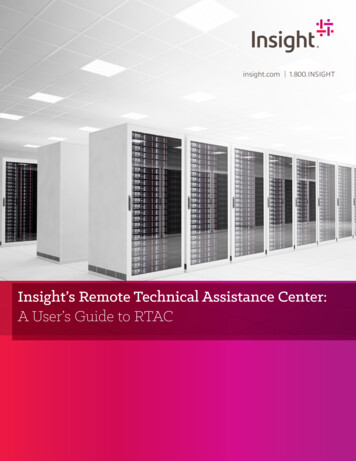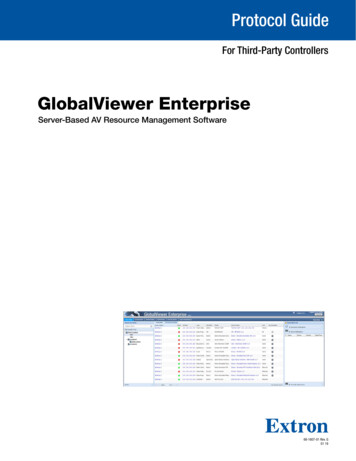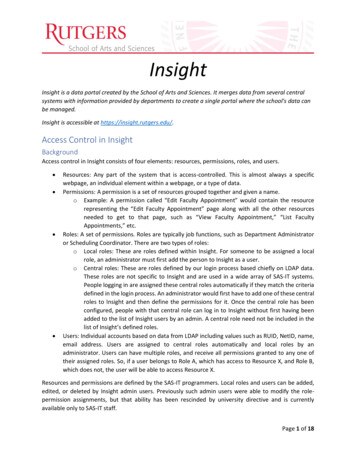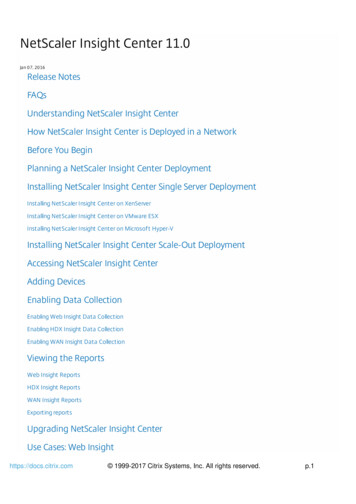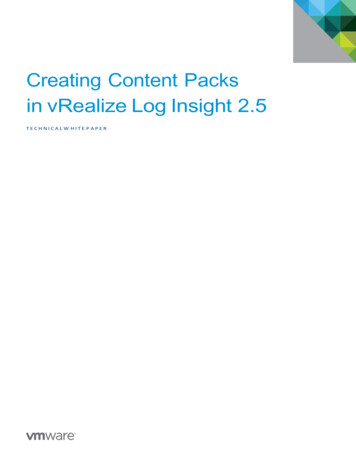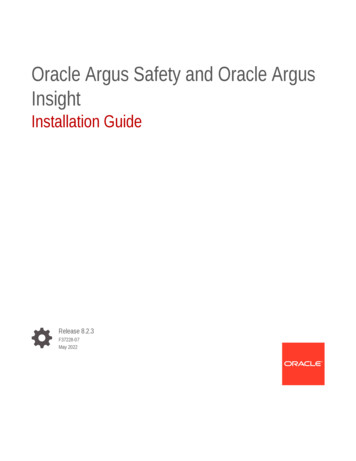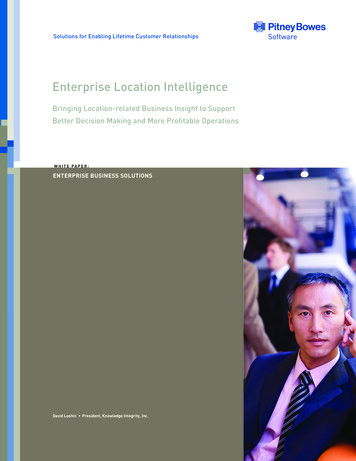
Transcription
Solutions for Enabling Lifetime Customer RelationshipsEnterprise Location IntelligenceBringing Location-related Business Insight to SupportBetter Decision Making and More Profitable OperationsW H I T E PA P E R :ENTERPRISE BUSINESS SOLUTIONSDavid Loshin President, Knowledge Integrity, Inc.
WHITE PAPER: ENTERPRISE BUSINESS SOLUTIONSEnterprise Location IntelligenceBringing Location-related Business Intelligence to SupportBetter Decision Making and More Profitable Operations2ABSTRACTIT IS NO LONGER A QUESTION AS TO WHETHER LOCATION INTELLIGENCE WILL BE INCORPORATED AS PART OF THE ENTERPRISEINFORMATION ARCHITECTURE, BUT RATHER HOW SOON LOCATION INTELLIGENCE WILL BECOME UBIQUITOUS ACROSS THE APPLICATIONENVIRONMENT. LOCATION INTELLIGENCE BLENDS THE ANALYSIS OF OBJECTS WITH THEIR SPATIAL ATTRIBUTES TO PROVIDEPOWERFUL CAPABILITIES THAT CAN BE INTEGRATED WITH BOTH OPERATIONAL AND ANALYTICAL APPLICATIONS FOR MULTIPLE USESTHROUGHOUT THE ENTERPRISE.www.pb.com/software
LOCATION INTELLIGENCE CAPABILITIES CAN HELP INCREASEREVENUES. DECREASE COSTS, AND IMPROVE PRODUCTIVITYThe Value of LocationThe growing popularity of mapping web sites andhandheld GPS (Global Positioning Satellite) devices isindicative of the continuing recognition of the value oflocation. And even with the growth of online shopping andvirtual commerce, all business transactions and eventsstill take place with the parties located at some physicala data base of named locations and other points ofinterest, a geocoding service could map any number ofplaces to their location coordinates, including airport orrailroad station codes, named points of interest, a streetintersection, or even analyzing text to extract place namesdescriptions. R everse Geocoding—Alternatively, the service canlocation. Clearly, the nature of business transactionsperform the reciprocal operation of reverse geocoding:and events is influenced by location as well as theproviding the nearest address or point of interest given aassociated demographics of the participating parties.set of latitude and longitude coordinates.And as commerce transitions to the World Wide Web,the corresponding growing volume of data related to thelocation of events and transactions can be analyzed inways that will contribute business insight among a varietyof operational and analytical dimensions, includinginfluencing consumer behavior, analyzing risk, identifyingcredible threats, evaluating tax dependencies, allocatingrelief funds, planning strategic military deployment, and A ddress Cleansing and Standardization—parsing andstandardizing street, city, and state information allows anaddress cleansing service to match against third-partydata to ensure that records meet published standards forpostal addressing. G eographic Data Enrichment—Many of the businessdrivers for location intelligence rely on combiningmany other ways of generating positive business value.location information with auxiliary data sets to enableWhat is Location Intelligence?standardized representations of regional hierarchiesLocation intelligence blends the analysis of objects (suchcleansed addresses against geographically-enriched dataas people, businesses, points of interest, or geographicregions) with their spatial attributes (such as averageage, median income, average driving distance, or averageeducational attainment) to inform decision-making foroperational efficiencies, revenue growth, or more effectivemanagement. These location intelligence capabilitiescan be integrated with both operational and analyticalapplications to help increase revenues, decrease costs,risk assessment, identification of taxing authorities, and(such as place/township/city/county/state). Matchingsets appends additional information (such as addresscorrections, demographic data imports, psychographicdata imports, and household data) in ways that enabledownstream analysis that will inform business decisions. M apping—A mapping service essentially combines thegeocoding capability with reporting and visualization toallow identification and tracking of the locations at whichand improve productivity and satisfaction:business transactions occur. A mapping service relies on G eocoding—As the fundamental location intelligencepoint of interest, etc.) to its coordinates and then locateservice, geocoding maps a named location (such as anaddress) to specific latitude, longitude (and potentiallyaltitude) coordinates on the earth’s surface. Geocodingservice may extend beyond address mapping; givengeocoding to transform a conceptual location (address,where the position of those coordinates on a map, as wellas allowing for editing, analyzing, and displaying valueadded associated data on a map.3
WHITE PAPER: INSURANCEEnterprise Location IntelligenceBringing Location-related Business Intelligence to SupportBetter Decision Making and More Profitable Operations4 D istance—There are different ways of figuring out theand routing updates, and emergency or accident routing.distance between two points, with the most basic beingIn addition location intelligence can be used for analyticthe “straight line” (also known as Euclidean) distance.purposes such as geographic targeting, fraud detection, siteHowever, there are potentially many different types oflocation, risk assessment and determination of premiumsdistance, such as driving distance, driving time, minimalfor insurance, dead zone analysis for telecommunicationtraffic lights, most fuel-efficient, etc. Distance calculationsutilities, among others. Some examples include:support proximity matching and searches for close-bypoints of interest. R outing—Routing leverages geocoding and distance P roximity Analysis—Real-time proximity analysis buildson geocoding to benefit a variety of business processes,ranging from consumer-directed activities such as findingcalculations and helps plan the trip among a collectionclosest points of interest (including hotels, restaurants, orof two or more points. This service looks at differententertainment), to expediting call routing and providingdistance calculations to present the most efficient pathsemergency assistance by determining locations forunder specific circumstances, using different weightingemergency calls, routing to the proper authorities, andfactors such as direct distance, driving distance, drivedirecting roadside assistance, police, or emergencytime, number of traffic lights, number of turns, speedmedical staff, especially for locations unreachable bylimits, and even real-time traffic reports and then presentstandard emergency vehicles.the best route based on the user’s specific criteria. P roximity Matching—Proximity matching searches for E ligibility and Service Provision—Many service providersand utilities may be limited in providing service basedrelevant objects and points of interest within a definedon the proposed service location. There may be physicalradial range. Proximity matching can find relevantlimits that need to be analyzed, such as a residence’spoints of interest near specified coordinates ordistance to a central office for DSL internet service,even named locations, and uses a knowledge baseor whether a residential area is served by public waterof categorized points of interest (such as “hotels,”and sewage systems or if a service location is served by“restaurants,” or “airports”) to provide a list of matchesexisting power lines. Location intelligence also contributeswithin the closest vicinity.to alternate operational processes with geographicdependence. Other examples include assessing residentialPutting Location Intelligence in PlaceBusiness applications typically use geographic data analysisfunctionality to pinpoint places on a map or presentingdirections among a set of locations. But more and more,location intelligence techniques are used to answerproperties to forecast investment requirements in utilityinfrastructures or determining which businesses arewithin areas that qualify for government subsidies foreconomic development. G eographic Targeting—Understanding the demographicquestions regarding spatial relationships that go beyondcharacteristics of prospects within different regionsjust putting points or drawing lines on a map.enables generalized targeted marketing, which employsgeocoding coupled with data enrichment to optimizeFundamental location intelligence services includetargeted communication to individuals within specificoperational uses such as address cleansing andlocations. Web advertisers often populate their contentstandardization, mapping, distance calculations, calculatingbased on the location of the IP addresses of their web sitenearest points of interest, risk assessment, real-time trafficvisitors, while print media, radio, and television contentproviders may localize their direct advertising.www.pb.com/software
LOCATION INTELLIGENCE TECHNIQUES ARE USED TO ANSWERQUESTIONS THAT GO BEYOND JUST PUTTING POINTS ON A MAP R educing Costs via Increasing Mailing Accuracy—facility and asset benefits the organization when it comesParsing, standardizing, and correcting addresses provideto planning, maintenance, ensuring consistent rental ratesdiscrete benefits. First, when postage rates are reducedand continuous occupancy, as well as optimized goodsfor high volume mailings with standardized addressesand services procurement (such as better pricing enabled(including bar codes) correcting and addresses so thatby collective purchasing arrangements for locations inthey meet defined postal standards usually reducesclose proximity).mailing costs. Simultaneously, ensuring high quality andaccurate addresses eliminates the risk of expendituresLocation intelligence provides benefits within specificon undeliverable or incorrectly delivered mail. Inindustries as well. Some examples include:addition, increased mailing accuracy leads to increased C rime Analysis and Fraud Detection—Location is ofopportunities, as it helps to target accurate delivery withgreater precision, resulting in more pieces reaching theintended audience, thereby increasing prospect andcustomer response rates. S ite Location—Even with a large degree of businessparticular interest for the purpose of analyzing andpreventing crime, and location intelligence is used ina number of scenarios. One example involves locatingand tracking persons of interest such as terrorists, drugdealers, money launderers, and others involved in criminalmigrating to the World Wide Web, many differentor regulated activities for the purposes of observationindustries (including retail, banking, healthcare, andand monitoring. Another area centers on fraud in whichhospitality, as well as public sector and social services)location data is combined with transaction data tostill rely on physical facilities. Location intelligence isidentify unusual patterns indicative of fraudulent behaviorused in considering how the different characteristics ofsuch as identity theft, stolen credit cards, and evenproposed locations are aligned with the organization’sinsurance or public assistance fraud.business needs. Retail organizations may classify sitedesirability based on centrality and accessibility withina region whose residents share certain demographic andbehavioral attributes. Wireless communication companiesmust both analyze “dead zones” with interruptions incontinuous service while simultaneously looking forappropriate tower sites based on zoning, local permittingconstraints, and community restrictions for utilityfacilities. A sset Allocation and Management—Networked I nsurance—High quality geographic information iscritical to the insurance industry, as risk is typicallytightly coupled with location. Home policy premiumsare influenced by situation within natural hazard zones,while insurance companies seek diversification of bothcore products within the same regions as well as marketdistribution across different regions. Location data isnecessary to complete the underwriting process andinforms operational activities such as balancing exposureto aggregate risk across different areas, catastropheorganizations that utilize multiple facilities (such asmanagement, assessing theft and damage potentials,universities, retail chains, health care networks, andand regulatory reporting to governmental agencies andhospitality companies) must maintain the physicalcommissions.buildings, manage activities and operations (such asdeliveries, utilities, or waste management) as well asthe assets (such as desks, beds, computers, etc.) locatedwithin those buildings. Knowing the location of each L ogistics—Two key directives within the logistics anddelivery industry are improved efficiency and reduction inrisk. Location intelligence addresses both of these driversby increasing delivery speed by providing directions to5
WHITE PAPER: INSURANCEEnterprise Location IntelligenceBringing Location-related Business Intelligence to SupportBetter Decision Making and More Profitable Operations6high quality standardized addresses and calculating theoptimized routing based on a collection of performancedistance measures, such as delivery routes calculatedbased on shortest distance can increase fuel efficiency.Risk can be reduced by planning routes in which thedelivery point is always positioned to the right of thevehicle, which reduces the risk of driver accidents.These are but a small set of examples of how locationintelligence has become a critical aspect of operationaland analytical business processes.Establishing Location Intelligence ServicesIt is no longer a question as to whether location intelligencewill be incorporated as part of the enterprise informationarchitecture, but rather how soon location intelligence willbecome ubiquitous across the application environment.One approach involves integrating vendor products thatimplement location intelligence using a services-orientedapproach that is equally easy to incorporate into bothoperational and analytical applications.Taking location intelligence to the next level meansLocation Intelligence and Trustworthy Dataacquiring location intelligence services, and vendorThere are two considerations regarding the quality ofthey meet business application needs. Some considerationsenterprise data to take advantage of location intelligence.include core functionality (such as geocoding, distanceFirst, the kinds of dimensional analyses provided bycalculations, mapping, routing, address standardization,data warehousing and business intelligence depend onand advanced spatial analytics), ease of use, alignment withenterprise reference data that conforms to well-defineddata integration and data quality tools and technologies,quality expectations. Standardized reference hierarchies,data enrichment, as well as functional integration andhigh quality point of interest names, locations, andapplication interoperability. Encapsulating locationaddresses are critical to organizing the right analysisintelligence services in a way that supports a broadmethods. Second, applying location intelligence to guidecapability will simplify the integration of geographic dataprofitable action requires organizational data sets to beservices with analysis, reporting, and visualization tools,of measurably high quality.which increases ease of use while reducing complexity.Repurposing existing data sets will introduce new data andFOR MORE INFORMATION ON LOCATION INTELLIGENCE SOLUTIONS,information quality requirements that may not be met byCALL PITNEY BOWES BUSINESS INSIGHT TODAY OR VISIT OUR WEBSITES.the upstream data suppliers, requiring additional integrateddata quality techniques. This means that one cannotrely on standalone tools for geographic analysis. Instead,location intelligence service must be tightly coupled withthe enterprise information management architecture. Inother words, anyone considering location intelligenceshould align that strategy with best practices in data qualitymanagement and data quality tools.www.pb.com/softwareproducts can be evaluated based on the degree to which
A LOCATION INTELLIGENCE STRATEGY SHOULD ALIGN WITH BESTPRACTICES IN DATA QUALITY MANAGEMENT AND DATA QUALITY TOOLS7
Every connection is a new opportunity UNITED STATESOne Global ViewTroy, NY om/softwareCANADA26 Wellington Street EastSuite 500Toronto, ON M5E .pbinsight.caEUROPE/UNITED KINGDOMMinton Place,Victoria StreetWindsor, Berkshire SL4 1EGUnited Kingdom o.uk/softwareASIA PACIFIC/AUSTRALIALevel 7, 1 Elizabeth PlazaNorth Sydney NSW 2060 e.singapore@pb.comwww.pbinsight.com.auPitney Bowes Software Inc. is a wholly-owned subsidiary of Pitney Bowes Inc.Pitney Bowes and the Corporate logo are [registered] trademarks of Pitney Bowes Inc. or a subsidiary.All other trademarks are the property of their respective owners. 2012 Pitney Bowes Software Inc. All rights reserved.92650 AM 1011
WHITE PAPER: INSURANCE Enterprise Location Intelligence Bringing Location-related Business Intelligence to Support Better Decision Making and More Profitable Operations In addition location intelligence can be used for analytic purposes such as geographic targeting, fraud detection, site location, risk assessment and determination of premiums
